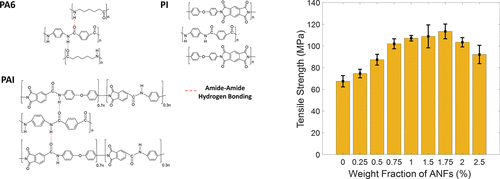当前位置:
X-MOL 学术
›
ACS Appl. Energy Mater.
›
论文详情
Our official English website, www.x-mol.net, welcomes your
feedback! (Note: you will need to create a separate account there.)
Aramid Nanofiber Reinforced Polymer Nanocomposites via Amide–Amide Hydrogen Bonding
ACS Applied Energy Materials ( IF 5.4 ) Pub Date : 2020-06-12 00:00:00 , DOI: 10.1021/acsapm.0c00430 Jalal Nasser 1 , Lisha Zhang 2 , Jiajun Lin 2 , Henry Sodano 1, 2, 3
ACS Applied Energy Materials ( IF 5.4 ) Pub Date : 2020-06-12 00:00:00 , DOI: 10.1021/acsapm.0c00430 Jalal Nasser 1 , Lisha Zhang 2 , Jiajun Lin 2 , Henry Sodano 1, 2, 3
Affiliation

|
Polymer nanocomposites have received tremendous attention over the past several decades; however, they can be challenging to implement without establishing chemical interaction between the nanofillers and the matrix. Poorly suited matrix materials can lead to agglomerations and poor interfacial stress transfer mechanisms, which limits the mechanical performance of the resulting polymer nanocomposites. Here, thermoplastic nanocomposites incorporating aramid nanofibers (ANFs) are studied, and it is shown that the performance of the nanocomposite is highly dependent on the similarity of the matrix with the ANF’s chemical structure, indicating that amide–amide hydrogen bonding leads to improved mechanical properties. Aramid nanofibers are initially isolated and used to prepare polyamide (PA6), polyamide–imide (PAI), and polyimide (PI) nanocomposites. Solution-cast ANF reinforced PA6 nanocomposites displayed more than 62% and 27% increase in their tensile strength and elastic stiffness, respectively. Similarly, ANF reinforced PAI nanocomposites exhibited more than 25% and 40% increase in their tensile strength and elastic stiffness, respectively. However, solution-cast ANF reinforced PI exhibited negligible improvement in strength and stiffness. The contrast in the performance of ANFs as nano-reinforcements in these nanocomposites is attributed to the ability of the ANFs to establish amide–amide hydrogen bonding in a PAI and PA6 matrix, whereas such interactions are unavailable in PI. This work shows that the introduction of ANF nanofillers may offer a rapid approach free of preprocessing to improve the mechanical properties of polyamide-based nanocomposites through amide–amide hydrogen bonding, allowing for cost-effective and simplified production of stronger polymer materials.
中文翻译:

通过酰胺-酰胺氢键形成的芳纶纳米纤维增强的聚合物纳米复合材料
在过去的几十年中,聚合物纳米复合材料受到了极大的关注。但是,如果不在纳米填料和基质之间建立化学相互作用,则难以实施。不合适的基质材料可能导致团聚和不良的界面应力传递机制,这限制了所得聚合物纳米复合材料的机械性能。在这里,研究了掺入芳族聚酰胺纳米纤维(ANFs)的热塑性纳米复合材料,该纳米复合材料的性能高度依赖于基体与ANF的化学结构的相似性,表明酰胺-酰胺氢键可改善机械性能。 。最初将芳族聚酰胺纳米纤维分离,并用于制备聚酰胺(PA6),聚酰胺-酰亚胺(PAI)和聚酰亚胺(PI)纳米复合材料。溶液浇铸的ANF增强PA6纳米复合材料的抗张强度和弹性刚度分别提高了62%和27%以上。同样,ANF增强的PAI纳米复合材料的抗张强度和弹性刚度分别提高了25%和40%以上。但是,溶液浇铸的ANF增强的PI在强度和刚度方面的改善可忽略不计。这些纳米复合材料中ANFs作为纳米增强材料的性能差异归因于ANFs在PAI和PA6基质中建立酰胺-酰胺氢键的能力,而在PI中则没有这种相互作用。
更新日期:2020-06-12
中文翻译:

通过酰胺-酰胺氢键形成的芳纶纳米纤维增强的聚合物纳米复合材料
在过去的几十年中,聚合物纳米复合材料受到了极大的关注。但是,如果不在纳米填料和基质之间建立化学相互作用,则难以实施。不合适的基质材料可能导致团聚和不良的界面应力传递机制,这限制了所得聚合物纳米复合材料的机械性能。在这里,研究了掺入芳族聚酰胺纳米纤维(ANFs)的热塑性纳米复合材料,该纳米复合材料的性能高度依赖于基体与ANF的化学结构的相似性,表明酰胺-酰胺氢键可改善机械性能。 。最初将芳族聚酰胺纳米纤维分离,并用于制备聚酰胺(PA6),聚酰胺-酰亚胺(PAI)和聚酰亚胺(PI)纳米复合材料。溶液浇铸的ANF增强PA6纳米复合材料的抗张强度和弹性刚度分别提高了62%和27%以上。同样,ANF增强的PAI纳米复合材料的抗张强度和弹性刚度分别提高了25%和40%以上。但是,溶液浇铸的ANF增强的PI在强度和刚度方面的改善可忽略不计。这些纳米复合材料中ANFs作为纳米增强材料的性能差异归因于ANFs在PAI和PA6基质中建立酰胺-酰胺氢键的能力,而在PI中则没有这种相互作用。

















































 京公网安备 11010802027423号
京公网安备 11010802027423号